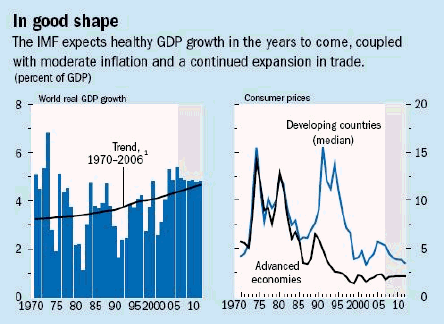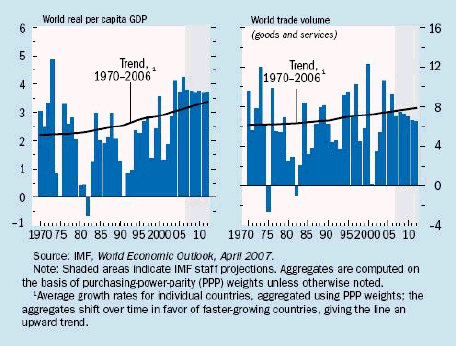
Typical street scene in Santa Ana, El Salvador. (Photo: iStock)
IMF Survey: Global Outlook Strong, Says IMF
April 11, 2007
- Recent financial market turbulence seems contained
- There are risks stemming from global economic imbalances
- U. S. housing market downturn is significant risk to the WEO forecast
Global economic growth will moderate to 4.9 percent in 2007 and 2008, from 5.4 percent in 2006, according to the IMF's World Economic Outlook (WEO).

Tanker loading crude: oil prices could spike given limited spare production capacity, says WEO (photo: Rob Crandall/SCW)
WORLD ECONOMIC OUTLOOK
This is a strong performance despite the recent volatility in world financial markets and difficulties in some parts of the U.S. housing market, the WEO added. Although economists judged that the risks to the forecast are lower now than they were six months ago when the last WEO was issued, those risks remain tilted to the downside. The WEO said five are worth noting:
• There could be a sharper slowdown in the United States if the housing market continues to deteriorate.
• Oil prices could spike given limited spare production capacity and continuing geopolitical uncertainties.
• Inflationary pressures could be rekindled as output gaps continue to close, particularly if there were another spike in oil prices.
• Continued volatility in financial markets could lead investors to move further away from risky assets.
• Global imbalances could unwind in a disorderly fashion. Although the probability of this occurring is low, the costs would be high.
Finally, from a longer-term perspective, several trends—including the aging of populations, rising political resistance to increasing globalization, and the environmental consequences of rapid growth—could undermine the buoyant productivity that has underpinned recent strong global growth.
Outlook for the large economies
Among the major advanced economies, the WEO predicts that the slowdown in year-on-year growth in 2007 will be most pronounced in the United States. The U.S. economy should gather some momentum again during the course of the year as the drag from the housing sector moderates in the second half of 2007, although a return to growth in line with potential is not expected until mid-2008. The U.S. Federal Reserve has kept interest rates on hold since June 2006, seeking to balance risks from a cooling economy and continuing concerns about inflation.
Growth is projected to ease in the euro area this year, following the best growth performance there in years in 2006. This projected slowdown reflects the gradual withdrawal of monetary accommodation and further fiscal consolidation, as well as the unwinding of certain onetime factors, such as the acceleration of consumption in Germany ahead of the preannounced increase in the value-added tax, which boosted growth in 2006.
In Japan, inflation readings remain uncomfortably close to zero, and the central bank has raised its policy interest rate only very gradually since exiting its zero interest rate policy in July 2006. But the IMF expects the expansion there to continue at about the same pace as last year, with the economy growing at 2.3 percent in 2007.

Emerging market economies and developing countries are expected to continue to grow strongly, although at a less torrid pace than in 2006. China's growth is expected to moderate to about 10 percent in 2007, from 10.7 percent in 2006. India's economy is also expected to slow, as economic policies are tightened to counter overheating. The IMF also expects commodity-rich countries in Africa, the Commonwealth of Independent States, the Middle East, and Latin America to continue to prosper, with growth in Africa accelerating to 6.3 percent in 2007.
How big are the risks?
The IMF sees about a one in five chance of global growth falling below 4 percent in 2008. The housing market downturn in the United States represents one of the most significant risks to the WEO forecast. Over the past few months, there have been some tentative signs of stabilization, at least on the demand side, with existing home sales and mortgage applications steadying, and even improving. But the housing correction is far from over. Housing starts and permits are still heading downward, whereas inventories of unsold homes remain close to their highest levels in 15 years. The subprime mortgage market, which constitutes about 12 percent of the total mortgage -market, is under duress, with sharp increases in delinquency and default rates.
The key question is whether the problems in the subprime market will affect the U.S. economy more broadly. Although house prices have continued to slow on a national level, with outright price declines in many metropolitan areas, household finances still look solid. Therefore, the WEO does not predict major spillovers from the current difficulties in the housing sector, provided that employment and income growth remain resilient. That said, there is still a risk that a sharper-than-expected slowing in house prices could lead to a more prolonged slowdown, particularly if consumption were affected through the impact on wealth and employment.


Inflation pressures in the advanced economies have generally eased, but concerns remain. In the United States, core inflation is still somewhat higher than the Federal Reserve's implicit comfort zone, and a gradual slowing of productivity growth is adding to cost pressures. In the euro area, price and wage increases remain subdued, but unemployment has fallen to cyclical lows, capacity utilization is high, and inflation pressures could emerge if labor markets continue to tighten. Output gaps are also closing in emerging markets, which means that the dampening effect of global competition on wages and prices in the advanced economies could start to moderate. Finally, inflation could increase as a result of spikes in commodity prices, not least in the price of oil.
Threats to financial stability
There are also threats to financial stability. Although the recent turbulence in financial markets appears to be contained, it serves as a healthy reminder of underlying financial risks. Recent years have been unusual for markets, with relatively low real interest rates and very low volatility despite monetary tightening by major central banks. The concern is that the drive for yield may have led to greater risk taking in less-well-understood markets and instruments. This strategy has been successful in buoyant markets, but price setbacks, rising volatility, and loan losses could lead investors to pull back from over-extended positions. Such an unwinding could have serious macroeconomic consequences.
Finally, there are risks stemming from global economic imbalances. Over the past six months, there has been some welcome movement toward containing global imbalances, which has reduced, although far from eliminated, the risk of a disorderly unwinding. There has been a further reduction in the real effective value of the dollar and some increased flexibility for the currencies of countries in Asia with large current account surpluses. There has also been a decline in the price of oil, and a somewhat more balanced pattern of global demand is emerging.
The bottom line
The sum of all these developments has not substantially changed the outlook for the global economy. But it would be a mistake to become complacent, the WEO warns. Policymakers need to remain vigilant to short-term macroeconomic risks while taking advantage of the continuing strong performance of the global economy to press ahead with more ambitious efforts to tackle deep-seated structural challenges.







